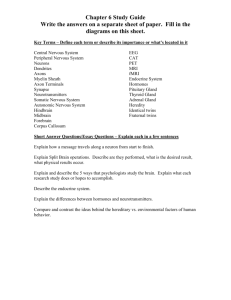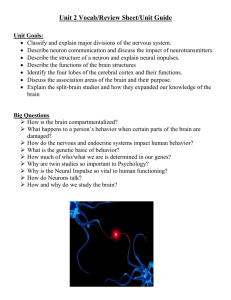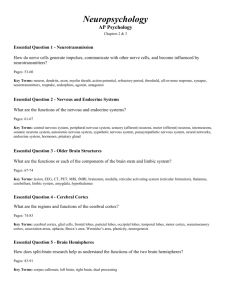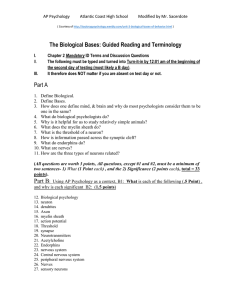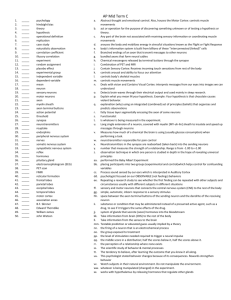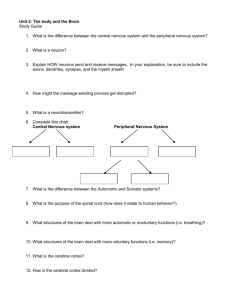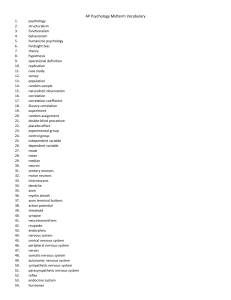Modules 6 and 7 Practice Quizzes
advertisement
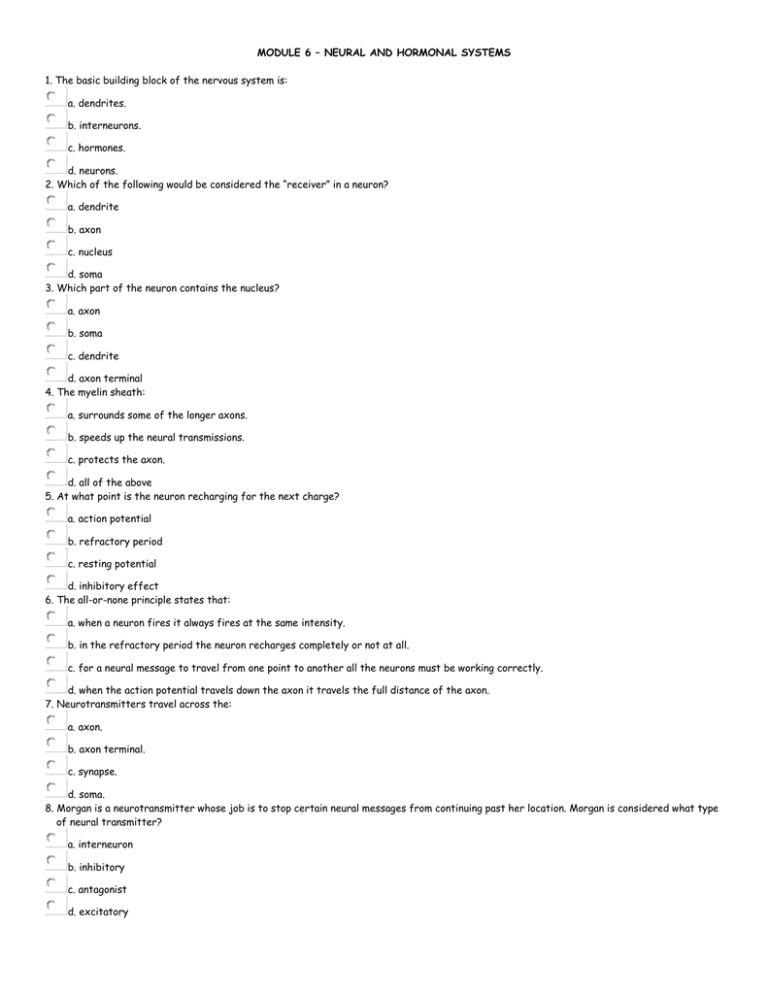
MODULE 6 – NEURAL AND HORMONAL SYSTEMS 1. The basic building block of the nervous system is: a. dendrites. b. interneurons. c. hormones. d. neurons. 2. Which of the following would be considered the “receiver” in a neuron? a. dendrite b. axon c. nucleus d. soma 3. Which part of the neuron contains the nucleus? a. axon b. soma c. dendrite d. axon terminal 4. The myelin sheath: a. surrounds some of the longer axons. b. speeds up the neural transmissions. c. protects the axon. d. all of the above 5. At what point is the neuron recharging for the next charge? a. action potential b. refractory period c. resting potential d. inhibitory effect 6. The all-or-none principle states that: a. when a neuron fires it always fires at the same intensity. b. in the refractory period the neuron recharges completely or not at all. c. for a neural message to travel from one point to another all the neurons must be working correctly. d. when the action potential travels down the axon it travels the full distance of the axon. 7. Neurotransmitters travel across the: a. axon. b. axon terminal. c. synapse. d. soma. 8. Morgan is a neurotransmitter whose job is to stop certain neural messages from continuing past her location. Morgan is considered what type of neural transmitter? a. interneuron b. inhibitory c. antagonist d. excitatory 9. Which nerve cells in the brain are responsible for processing information? a. receptor cells b. neurotransmitters c. axon terminals d. sensory nerves 10. Jimmy is a drug that enhances the effects of a neurotransmitters. Jimmy is known as a(n): a. soma. b. antagonist. c. resting potential. d. agonist. 11. Which of the following is a neurotransmitter? a. serotonin b. antagonist c. agonists d. somas 12. The central nervous system is made up of the: a. autonomic and somatic nervous systems. b. peripheral and autonomic nervous systems. c. sympathetic and parasympathetic nervous systems. d. brain and spinal cord. 13. Which nervous system prepares the body for the “fight or flight response”? a. central nervous system b. sympathetic nervous system c. parasympathetic nervous system d. somatic nervous system 14. Which of the following is called the “master gland”? a. adrenal gland b. thyroid gland c. pituitary gland d. pancreatic gland 15. Mallory is quietly reading a book in the school library when Stephanie comes up behind her and loudly puts her books down on the desk. Mallory is quite startled, her heart starts to pound, and epinephrine begins to run through her blood system. Mallory’s reaction is most likely due to which gland? a. thyroid b. hypothalamus c. pancreatic d. adrenal MODULE 7 – THE BRAIN 1. The oldest, most basic part of the brain is the: a. medulla. b. cerebral cortex. c. brainstem. d. cerebrum. 2. Which of the following is responsible for controlling your basic life support functioning? a. medulla b. thalamus c. amygdala d. spinal cord 3. Often during sleep studies, electrodes are attached to the subject’s head to record the electrical activity of the brain during sleep. This form of brain measurement is referred to as: a. a PET scan b. an EEG c. a MRI d. a CAT scan 4. Phineas was just involved in an accident at work. At the hospital, the doctors order a scan in which Phineas is injected with a radioactive form of glucose. Most likely Phineas is getting a(n): a. EEG. b. PET scan. c. MRI. d. CT scan. 5. The thalamus handles incoming messages from all of the senses except for: a. taste. b. smell. c. touch. d. hearing. 6. Which part of the brain is helping you coordinate your muscles to operate the computer mouse to take this quiz? a. cerebellum b. longitudinal fissure c. amygdala d. occipital lobe 7. Which of the following make up the limbic system? a. hypothalamus, cerebral cortex, and longitudinal fissure b. cerebral cortex, medulla, and cerebellum c. parietal, occipital, and temporal lobes d. hypothalamus, hippocampus, and amygdala 8. The longitudinal fissure divides the brain into two: a. lobes. b. fissures. c. hemispheres. d. cortexes. 9. The large band of neurons which connect the two halves of the brain is called the: a. corpus callosum. b. amygdala. c. occipital lobe. d. thalamus. 10. Jean is in charge of planning and coordinating a local charity drive. Which part of Jean’s brain will help her the most in planning the drive? a. temporal lobes b. motor cortex c. frontal lobes d. occipital lobes 11. As you look at this question, which part of your brain is responsible for processing the information from your eyes? a. somatosensory cortex. b. motor cortex. c. temporal lobes. d. occipital lobes. 12. Walking down the hall at school, someone accidentally bumps into to you. The part of your brain which registers that sensation of touch is the: a. somatosensory cortex. b. motor cortex. c. temporal lobes. d. occipital lobes. 13. You have just finished reading this module and are explaining it to a classmate. Which of the following is accurate? a. You are using Broca’s area to explain the module and your classmate is using Broca’s area to understand what you are saying. b. You are using Broca’s area to explain the module and your classmate is using Wernicke’s area to understand what you are saying. c. You are using Wernicke’s area to explain the module and your classmate is using Wernicke’s area to understand what you are saying. d. You are using Wernicke’s area to explain the module and your classmate is using Broca’s area to understand what you are saying. 14. A split-brain patient has had their corpus callosum severed in order to: a. increase the production of neurotransmitters. b. reduce symptoms of depression. c. correct a problem in Broca’s area. d. help treat severe epilepsy. 15. Mikhail is a split-brain patient being tested by Dr. Gazzaniga. Mikhail is asked to fixate on a dot in the center of the screen and then shown the word “sidewalk” split in half by the dot. According to current research, what should Mikhail be able to do when asked what word he saw? a. write the word “walk” with his left hand b. write the word “side” with his right hand c. write the word “walk” with his right hand d. write the word “sidewalk” with his left hand
